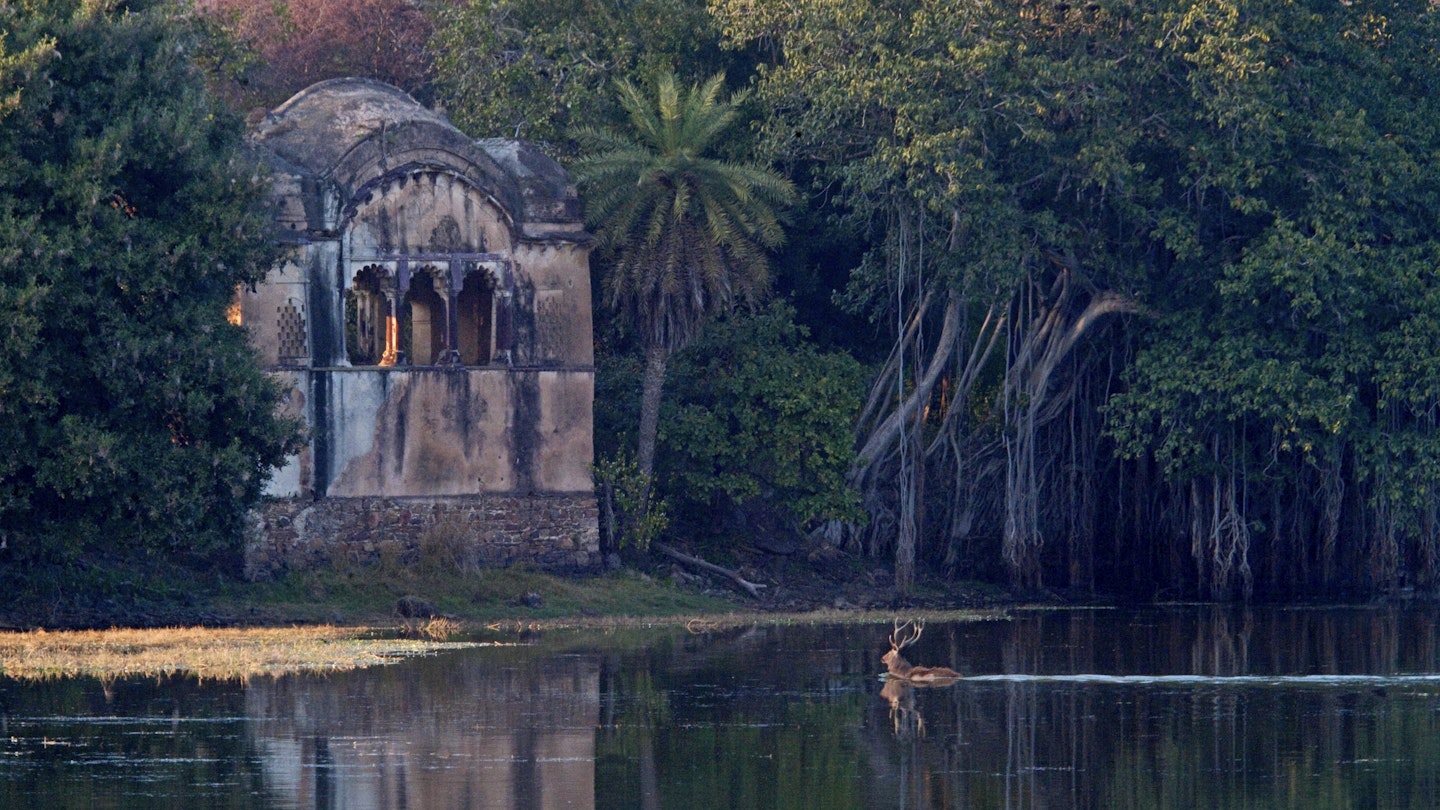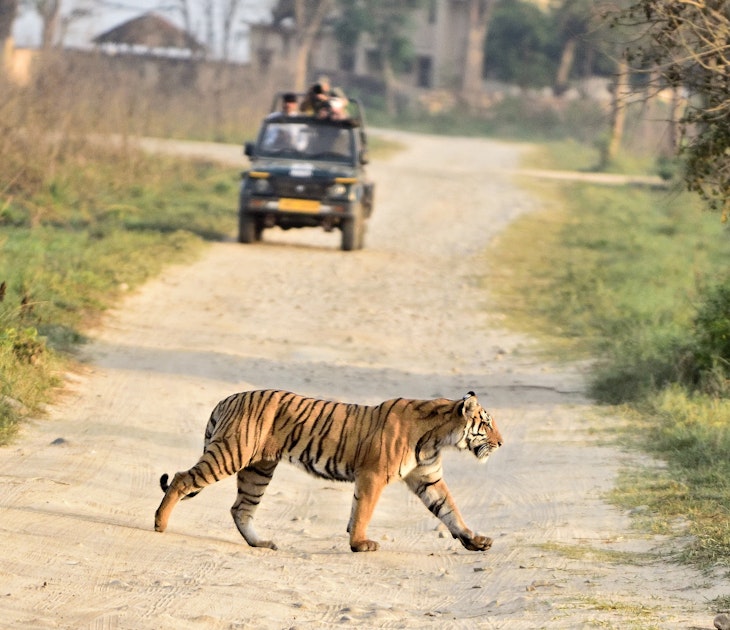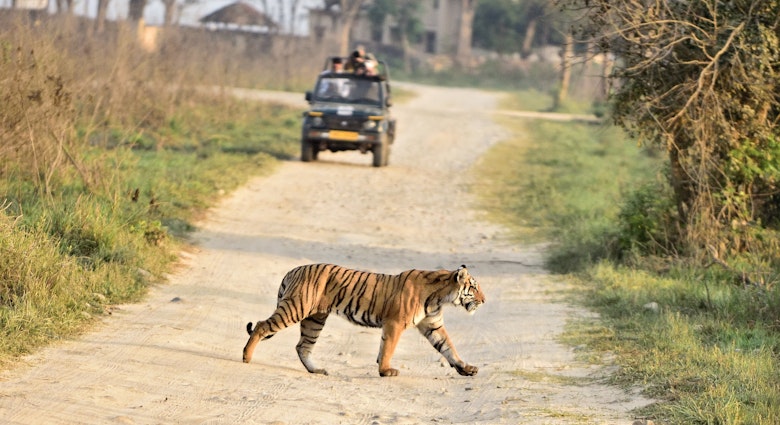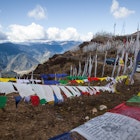Half a century ago there were just five national parks in India, today there are more than 100. From the towering Himalayas and the plains of Central India to the Western Ghats and the world’s largest mangrove forests in the east, these wildlife reserves have been created to protect the abundance of wildlife, much of it endemic and endangered.
The numbers are staggering: India is home to 70% of the world’s tigers, 60% of its Asian elephants, plus more than 1360 species of bird, 600 reptiles and 400 mammals, many not seen anywhere else.
Operated exclusively by the government and forest authorities, the national parks are a haven for vulnerable species like snow leopards, lions, and one-horned rhinos, and for tourists, a safari can be a great way to see each of them in their natural habitat. Plan your visit to India around these top national parks.
Jim Corbett National Park, Uttarakhand
Named contentiously after the British hunter and naturalist Jim Corbett, this is the oldest national park in India. Established in 1936, it spreads over 520.8 sq km of dense, deciduous forests in the Himalayas foothills and delights pantheists with its rolling hills, ridges and ravines, and vast expanses of savannah, open grasslands, swamps, and marshes.
The forest groves of sal and sacred fig are native to the subcontinent and home to more than 600 species of birds. Aside from 50 species of mammal, the park is also home to leopards, elephants, sloth bears, spotted deer, langur monkeys, and gharials (fish-eating crocodiles). Tiger sightings are rare, but elephant herds are often seen amongst the verdant grasslands and near water.
A slew of outdoor adventures are on offer here, including river rafting and mountain biking. Ask your hotels or tour operator for details. The park's Corbett Museum can also give visitors an insight into the man himself.
Visiting Jim Corbett National Park
Some 260km northeast of Delhi, the closest town to Jim Corbett National Park is Ramnagar, 15km away. Visitors can stay at guesthouses inside the park, by booking online. Private resorts outside of the park can also assist with safari bookings. Book all day trips and 4WD safaris in advance.

Kaziranga Wildlife Park, Assam
Should you spot a crash of one-horned rhinoceros here, you've one person to thank: Baroness Mary Curzon. Spread along the plains of Brahmaputra River in northeast India for some 430 sq km, Kaziranga Wildlife Park is home to more than two thirds of the world’s population of these rhino, but they had been virtually wiped out until Curzon, the wife of the Viceroy, expressed her disappointment when she failed to spot a single rhino in the wild.
Curzon's persuasion led to conservation efforts with Kaziranga Reserve Forest formed in 1905. A century on, the park is not only home to rhinos, but is a breeding ground for wild elephants, water buffalos, and swamp deer. Tigers and leopards also lurk in the tropical broadleaf forests but are masters of disguise. Birdwatchers throng here to spot endemic and migratory birds such as Blyth's kingfishers and white-bellied herons.
Visiting Kaziranga National Park
Around 195km northeast of Guwahati, the main gate to Kaziranga National Park is at Kohora. Safaris must be booked in advance. The park is closed from May to October due to the monsoon. Forest guides accompany all tours and hiking is prohibited. A number of wildlife lodges outside of the park manage safaris.
Kanha National Park, Madhya Pradesh
The deciduous forests, towering sal trees, grasslands, and bamboo groves of this 940-sq-km national park were the inspiration behind The Jungle Book by Rudyard Kipling and Shere Khan, the Bengal tiger in the novel, is definitely the headliner here.
Conversation efforts inside the park have brought the swamp deer back from extinction here and a road inside the forest takes its name from George Schaller, the conservationist who penned The Deer and the Tiger about his experience.
Starting before dawn, take an open-topped 4WD safari through long holloways of tall sal and bamboo trees looking for wildlife such as langurs, sloth bears, leopards, wild dogs, and spotted- and sambar deer. The forest department can arrange 2km to 3km guided nature walks along buffer zones and banks of the River Banjar. These include birdwatching and occasional elephant sightings.
Originally home to the Baigas and Gonds tribal communities, the true guardians of the forests, you can visit their villages to better understand their rituals, customs, and traditions. Tours are conducted by Last Wilderness Foundation.
Visiting Kanha National Park
Open October to June, the closest airport and railway station to Kanha National Park is 160km away at Jabalpur. It offers a number of tented camps, wildlife lodges, and luxury resorts. Safaris must be booked online in advance. Some private lodges organize guided walking and cycling trails.

Bandhavgarh National Park, Madhya Pradesh
Legend has it that Bandhavgarh, an ancient fortress in the Umaria District of Madhya Pradesh, is as old as the epic Ramayana itself. Sadly not accessible to travellers, the fort was believed to be built by Lord Ram for his brother, Lakshman. But that's not the only myth to swirl around these parts: a legendary white tiger was said to inhabit the forests here too. The last of the species, Mohan, lies stuffed and on display in the palace of Maharaja of Reva.
These erstwhile royal hunting grounds are now part of a national park, covering an area of 716 sq km of mixed deciduous forests and grasslands. Over 300 species of birds and 80 species of butterflies flit and fly about, while mammals, including tigers, leopards, sloth bears, Indian wolf, caracals, gaurs, langurs, and a variety of deer and antelope species can be spotted here.
For an aerial view of the park, there are hot air balloon safaris available. On land though, tigers favour the Tala Zone. One of their hideouts is a 1000-year-old carved sculpture of a reclining Lord Vishnu under the canopy of a seven-headed snake. A small pool near the 11m-long carving is busy with wild cats, especially in summer. Badi Guha, a dark natural cave, is also a den for tigers and is home to bats. There are three zones in the main area of the park, with Tala the best place to head for wildlife sightings.
Visiting Bandhavgarh National Park
It is only possible to visit Bandhavgarh National Park from October to June as it closes during the monsoon season. The closest airports are Jabalpur (200km away) and Khajuraho (250km). Safaris have to be booked online in advance – tour operators and nearby resorts can assist with the bookings.
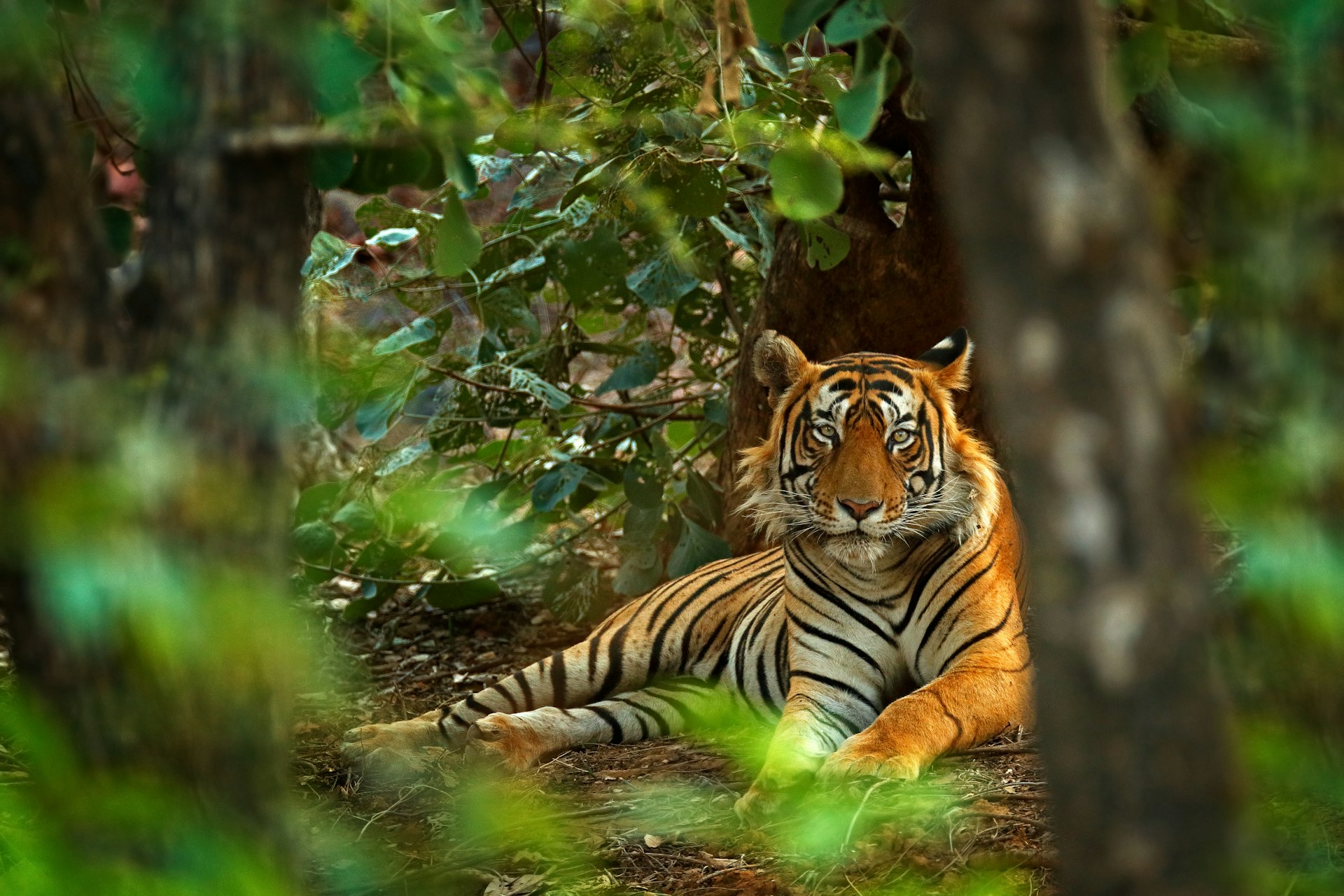
Ranthambore National Park, Rajasthan
Forts are integral to Rajasthan's landscape and a crumbling bastion forms the very nucleus of this national park. Covering some 1334 sq km of deciduous forests and grasslands, the park was the former hunting grounds of the Jaipur Maharaja, who built Sawai Madhopur, the park's main entrance town. The royal hunting lodge is now a premium hotel.
Tigers and leopard are the highlights here, but you're more likely to spot water buffalo, wild boars, striped hyenas, langurs, wild dogs, mongoose, and several species of deer. Tours are by open-top jeep and the three lakes that mirror the wilderness add a dash of magic to the tour.
Inside the park are a smattering of temples, havelis (mansions), vaults and water tanks, giving visitors a glimpse of the Rajput heritage. The ruins of this 1000-year-old site are scattered in the forests and are often used as hideouts for the big cats. On safari look out for the striking Jogi Mahal, a former hunting lodge, built in red sandstone as well as crumbling arches, pillars, domes, and broken steps, near the lakes, Raj Bagh Talao and Padam Talao. The forest department also offers bird-watching and crocodile safaris.
Visiting Ranthambore National Park
Located 175km from Jaipur, Sawai Madhopur is the closest town to Ranthambore National Park, at 14km away. Divided into ten core zones, permits and safaris for the park must be booked online. Accommodation is available in the town and around the park, but not inside.

Gir National Park, Gujarat
Welcome to the lion's den. This 1412-sq-km park is king of the jungle territory. Once the private hunting lodge of the Nawab of Junagadh, a former princely state in present day Gujarat, lions were hunted here by royalty during the British colonial era – only for them to realise that there were hardly any left. A small sanctuary for these big cats eventually led to the creation of this national park.
There is nothing more thrilling than an early morning safari in the thick wooded area, where a deafening roar can suddenly jolt you out of your stupor or a glimpse of the golden mane between the trees can send a chill down your spine. There are no other wild cats vying for your attention here. Even the leopards are elusive. But when you are in the land of the lions, you rarely look elsewhere.
Gir is home to about 40 species of mammal and 300 species of birds, too. You may encounter the different species of deer, antelopes, gazelles, jackals, and langurs. If you want to see lions, they're often found by watering holes, sometimes with lionesses and cubs. The park was once home to indigenous Maldharis and Siddhis tribes, but they have been relocated to villages outside the sanctuary. It is possible to book trips to see their villages, temples, and dances; ask your tour operator or hotel about what is possible.
Visiting Gir National Park
Some 165km south of Rajkot, the best place to book a Gir National Park safari is in Devalia. The park has several designated zones and safari routes. Permits can be booked online, though a number of resorts outside of the park can manage tours too. The park is closed mid-June to mid-October due to monsoon season.
Hemis National Park, Jammu and Kashmir
The “Ghost of the Mountains” silently wanders in the impenetrable high-altitude mountains of Ladakh, a master of disguise camouflaging with the snow and ice of Hemis National Park. The haunt of the elusive snow leopard is the largest national park of India, covering 4400 sq kms of alpine forests across the Karakoram–West Tibetan Plateau. Nestled at altitudes that range from 12,000 and 20,000ft, this Palearctic realm is one of the eight biogeographic realms of our planet.
Named after the ancient Hemis Monastery, this park boasts the highest density of snow leopards in the world, but visitors will more likely spot the bharal (blue sheep), shapu (Ladakhi urial), the Great Tibetan Sheep, and Asiatic ibexes.
Himalayan marmot, Tibetan wolf and the endangered Eurasian brown bear also call this vast steppe home. The Rumbak region is the best place for wildlife spotting. Look up to catch a glimpse of the Golden Eagle, the Himalayan griffon vulture, and several other birds of prey.
Many travelers come here to hike with the Markha Valley Trek a favourite, whilst professional mountaineers attempt to scale the Stok Kangri Peak (20,000ft) and the Kang Yatse Peak (21,000ft). As well as the 12th-century Hemis Monastery, there are several chortens and gompas in the park.
Visiting Hemis National Park
Leh is the closest airport to Hemis National Park with the main entrance at Chilling, though there are gates at Stok, Zingchen, and Martselang too. Permits are required to enter the park and local tour operators organize treks here. Only locals are allowed motorized vehicles inside the park.
Nagarhole National Park, Karnataka
In Kannada, the local language, Nagarhole translates to “snake river” and that's exactly what the River Kabini does through this wonderful south Indian park, it swoops and curls through the forests of Bandipur and Nagarhole.
Memories of elephants throng the river banks, sometimes in huge congregations during the summer. Carpeting some 848 sq km of the Western Ghats, including the foothills of the Brahmagiri Hills, this park is part of the Nilgiri Biosphere Reserve and shares its borders with the Wayanad Wildlife Sanctuary.
The former hunting grounds of the Mysore Maharaja, the park now focuses on conservation projects. Safaris can be very rewarding here with elephants, wild dogs, sloth bears, gaurs, wild boars, tigers, and leopards all commonly sighted. Several species of deer, langurs, and monkeys are often sighted too, particularly along the backwaters of the Kabini. Birdwatching is a delight with a blend of both water and woodland birds, alongside several migratory species each winter. Crocodiles and snakes are regular sights as well, making this a great all-rounder for wildlife fans.
Visiting Nagarhole National Park
Around 80km from Mysore, safaris and stays at Nagarhole National Park are arranged by the forest department, though Kabini River Lodge – an erstwhile royal hunting lodge – can sort 4WD safaris, nature walks, boat rides, and river safaris inside the park for their guests. There are several luxury wildlife resorts located around the Kabini backwaters where travelers can stay.
You might also like:
Of the countless amazing places to visit in India, these are the 10 best
Understanding India: everything you need to know before you travel
India on a budget: 10 ways to get the best experience for less

